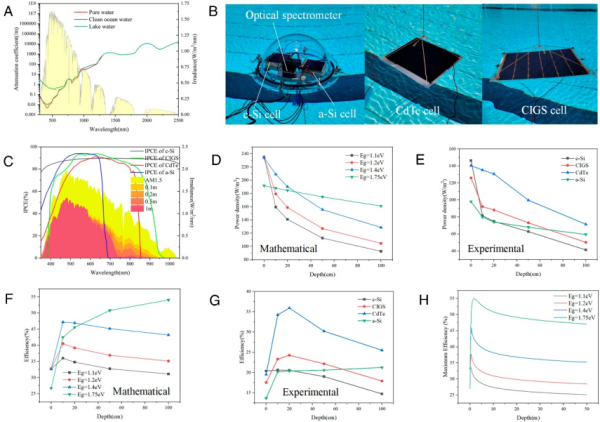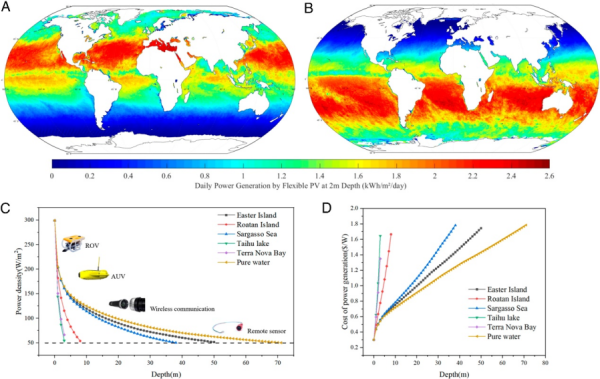
Recently, the research team led by Researcher Lv Song from the School of Naval Architecture, Ocean and Energy Power Engineering achieved significant progress in underwater solar energy utilization. The research findings, titled “Maximizing Underwater Energy Harvesting Efficiency Using Flexible Solar Cells: A Pathway to Sustainable Ocean Power”, were published in the latest issue of Proceedings of the National Academy of Sciences (PNAS). Wuhan University of Technology is the sole institutional affiliation, with doctoral student Bai Haoliang as the first author and Researcher Lv Song as the corresponding author.
Through theoretical modeling and experimental testing, the research team systematically analyzed the operational depth and optimal band gap of underwater solar cells (UWSC). They established the first optical model for flexible underwater solar cells, simulated the optical behavior of sunlight underwater, and validated a curvature optimization strategy for UWSC through outdoor experiments. The results indicate that each UWSC has an optimal depth to achieve peak efficiency, primarily due to the close match between the IPCE spectrum of UWSC and the underwater spectrum. Model predictions show that flexible solar cells with optimal curvature can generate 9.4% to 15.9% more daily energy output at depths of 2 to 50 meters than traditional planar solar cells. Notably, a flexible a-Si solar cell with optimal curvature achieved a maximum efficiency of 59.7% at a depth of 2 meters underwater. This theoretical breakthrough surpasses the fundamental limitations of underwater solar energy harvesting and outperforms existing underwater photovoltaic solutions.

Figure 1. Determining the Optimal Photovoltaic Technology for Underwater Applications
Based on this, the team demonstrated the capability of various UWSCs to power unmanned underwater vehicles (UUVs) and LED beacons. They analyzed their performance limits and operational durations in different water bodies, confirming the potential of UWSCs as standalone power sources in underwater environments. Furthermore, the team explored the global power generation potential of flexible UWSCs at typical depths. This achievement not only advances the adaptability of underwater photovoltaic technology but also provides a long-lasting, stable, and systematic solution for future marine renewable energy utilization.

Figure 2. Application Potential of Underwater Photovoltaic Power Generation
Article Link: https://www.pnas.org/doi/10.1073/pnas.2423651122
Proceedings of the National Academy of Sciences of the United States of America (PNAS), founded in 1914, is a globally renowned comprehensive scientific journal on par with Nature, Science, and Cell. It is one of the most frequently cited multidisciplinary publications, covering biology, materials science, physics, chemistry, atmospheric sciences, engineering, ecology, and social sciences.
Written by: Lv Song
Rewritten by: Mei Mengqi
Edited by: Wang Jingjing, Li Huihui, Li Tiantian
Source: School of Naval Architecture, Ocean and Energy Power Engineering
|
|